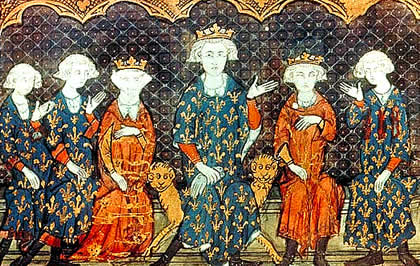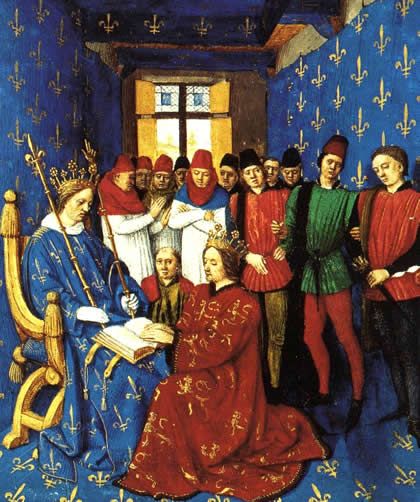World History
Philip IV, also known as “Philip the Fair,†was born in 1268 to Philip III and Isabel of Aragon and succeeded his father as king of France upon the latter’s death in October 1285.
As earlier Capetian monarchs, Philip enhanced the size of royal territory, adding the lands of Champagne and Brie through his marriage to Jeanne of Navarre in 1284, and forcibly subjecting much of Flanders to French suzerainty in 1305.
In his endeavor to wrestle control of the duchy of Gascony away from the English King Edward I (1272–1307), Philip clashed with the medieval papacy over the issue of royal authority in France.
Philip provoked hostilities with Edward in 1296 when he seized much of Gascony. Preparing to repulse Edward’s invasion of France, Philip levied a tax on the French clergy in order to pay for the war.
Pope Boniface VIII (1294–1303) vehemently objected to Philip’s actions, holding that by canon law kings could only tax clergy in consultation with the pope. His bull Clericis laicos (1296) asserted this position and threatened excommunication to any ruler who attempted to tax the clergy of his land without papal approval.
In retaliation Philip halted all revenues from France to Rome, forcing Boniface to relent and acknowledge that Philip had the right freely to tax the clergy of France for the defense of the realm.
The two rulers clashed again over royal authority in 1301 when Philip’s officials, ignoring the practice of clerical immunity from secular courts, arrested the French bishop Bernard Saisset on charges of treason and prepared to try him in a royal court.
Defying Boniface’s order to shift the trial to Rome and the pope’s subsequent threats, Philip convened the first meeting of the Estates General in France (1302–03), to gain the backing of the nobles, clergy, and burghers in his quarrel with the pope.
In 1302 Boniface issue the bull Unam sanctam, which asserted the most extensive claims of the papacy to intervene in secular affairs ever voiced in the Middle Ages. With Philip still in defiance, in 1303 Boniface prepared to excommunicate the king, but Philip struck first.
His agents attempted to kidnap the pontiff from his summer palace in Anagni, south of Rome, and bring him back to France to stand trial as a heretic and schismatic. While the attempt failed, the aged pontiff was so unsettled that he died shortly thereafter.
Following the brief pontificate of Benedict XI (1303–04), Philip pressured the college of cardinals to elect the bishop of Bordeaux pope, who took the name Clement V (1305–14). Clement moved the papacy to Avignon in southern France, thus beginning the era of the “Babylonian Captivity†of the church.
Philip’s ruthlessness and ambition, clearly evident in his handling of Boniface VIII, were fueled by lawyers and other advisers who implemented his policy. Unscrupulous and apparently unfettered by morality, men such as Guillaume de Nogaret championed a view of royal power and authority that left no room for rivals.
We need look no further than Philip’s treatment of the Jews or of the order of the Knights Templar in France. Running short of money to finance his wars, in 1306 Philip ordered the Jews out of France, confiscated their property, and took over the collection of all the debts owed to them.
The following year he set about systematically destroying the wealthy and powerful Templars, who had become large financiers of the royal debt. By 1312 Philip, backed by Clement V in Avignon, had destroyed this once proud military order in France, executing many of its members on charges of heresy and confiscating their wealth for the royal coffers.
Both the reach and efficiency of royal government grew under Philip. He showed great acumen in developing the tools of government that enabled him to rule efficiently.
He established the Chambre des Comptes, or the royal treasury, and developed the royal court known as the Parlement, which made royal justice available to nobles and burghers alike. Collectively Philip’s rule marked the apogee of the late medieval monarchy in France.
- Hugh Capet
Hugh Capet The founder of the Capetian dynasty of French kings (987–1328), Hugh Capet was born the second son of Hugh the Great, duke of Francia and count of Paris, and Hedwig, sister of Otto I, the emperor of Germany. In 961 he was made duke of...
- Valois Dynasty
Valois Dynasty The branch of the Capet family who ruled France from 1328 to 1589, the Valois, descended from 1285 when Philip III gave the county of Valois to his brother Charles. Charles’s son succeeded to the throne of France when the direct...
- Vatican Publishes Knights Templar Papers
The Knights Templar are one of the most famous (infamous?) of Medieval organizations. They protected the Holy lands for Christianity for centuries. Their success was tied closely to the Crusades and when the Crusaders lost the Holy Land, support for the...
- The Joan Of Arc Archive
The Joan of Arc Archive. An examination of the life of this saint, scanned images of her letters and other original manuscripts, quotations, and other items of interest. From the site: She was born on January 6th around the year 1412, to Jacques and Isabelle...
- The Funeral Of Duke Philip The Good
The Funeral of Duke Philip the Good - How the Funeral of Philip the Good (died 1467) was used by the Burgundian aristocracy to demonstrate their ducal power and munificence. From the site: The whole history of the house of Burgundy is like an epic...
World History
Philip IV - King of France
 |
| Philip IV - King of France |
Philip IV, also known as “Philip the Fair,†was born in 1268 to Philip III and Isabel of Aragon and succeeded his father as king of France upon the latter’s death in October 1285.
As earlier Capetian monarchs, Philip enhanced the size of royal territory, adding the lands of Champagne and Brie through his marriage to Jeanne of Navarre in 1284, and forcibly subjecting much of Flanders to French suzerainty in 1305.
In his endeavor to wrestle control of the duchy of Gascony away from the English King Edward I (1272–1307), Philip clashed with the medieval papacy over the issue of royal authority in France.
  |   |
Philip provoked hostilities with Edward in 1296 when he seized much of Gascony. Preparing to repulse Edward’s invasion of France, Philip levied a tax on the French clergy in order to pay for the war.
Pope Boniface VIII (1294–1303) vehemently objected to Philip’s actions, holding that by canon law kings could only tax clergy in consultation with the pope. His bull Clericis laicos (1296) asserted this position and threatened excommunication to any ruler who attempted to tax the clergy of his land without papal approval.
In retaliation Philip halted all revenues from France to Rome, forcing Boniface to relent and acknowledge that Philip had the right freely to tax the clergy of France for the defense of the realm.
The two rulers clashed again over royal authority in 1301 when Philip’s officials, ignoring the practice of clerical immunity from secular courts, arrested the French bishop Bernard Saisset on charges of treason and prepared to try him in a royal court.
Defying Boniface’s order to shift the trial to Rome and the pope’s subsequent threats, Philip convened the first meeting of the Estates General in France (1302–03), to gain the backing of the nobles, clergy, and burghers in his quarrel with the pope.
In 1302 Boniface issue the bull Unam sanctam, which asserted the most extensive claims of the papacy to intervene in secular affairs ever voiced in the Middle Ages. With Philip still in defiance, in 1303 Boniface prepared to excommunicate the king, but Philip struck first.
His agents attempted to kidnap the pontiff from his summer palace in Anagni, south of Rome, and bring him back to France to stand trial as a heretic and schismatic. While the attempt failed, the aged pontiff was so unsettled that he died shortly thereafter.
Following the brief pontificate of Benedict XI (1303–04), Philip pressured the college of cardinals to elect the bishop of Bordeaux pope, who took the name Clement V (1305–14). Clement moved the papacy to Avignon in southern France, thus beginning the era of the “Babylonian Captivity†of the church.
Philip’s ruthlessness and ambition, clearly evident in his handling of Boniface VIII, were fueled by lawyers and other advisers who implemented his policy. Unscrupulous and apparently unfettered by morality, men such as Guillaume de Nogaret championed a view of royal power and authority that left no room for rivals.
 |
| Philip IV (seated) and Edward I (kneeling) |
We need look no further than Philip’s treatment of the Jews or of the order of the Knights Templar in France. Running short of money to finance his wars, in 1306 Philip ordered the Jews out of France, confiscated their property, and took over the collection of all the debts owed to them.
The following year he set about systematically destroying the wealthy and powerful Templars, who had become large financiers of the royal debt. By 1312 Philip, backed by Clement V in Avignon, had destroyed this once proud military order in France, executing many of its members on charges of heresy and confiscating their wealth for the royal coffers.
Both the reach and efficiency of royal government grew under Philip. He showed great acumen in developing the tools of government that enabled him to rule efficiently.
He established the Chambre des Comptes, or the royal treasury, and developed the royal court known as the Parlement, which made royal justice available to nobles and burghers alike. Collectively Philip’s rule marked the apogee of the late medieval monarchy in France.
- Hugh Capet
Hugh Capet The founder of the Capetian dynasty of French kings (987–1328), Hugh Capet was born the second son of Hugh the Great, duke of Francia and count of Paris, and Hedwig, sister of Otto I, the emperor of Germany. In 961 he was made duke of...
- Valois Dynasty
Valois Dynasty The branch of the Capet family who ruled France from 1328 to 1589, the Valois, descended from 1285 when Philip III gave the county of Valois to his brother Charles. Charles’s son succeeded to the throne of France when the direct...
- Vatican Publishes Knights Templar Papers
The Knights Templar are one of the most famous (infamous?) of Medieval organizations. They protected the Holy lands for Christianity for centuries. Their success was tied closely to the Crusades and when the Crusaders lost the Holy Land, support for the...
- The Joan Of Arc Archive
The Joan of Arc Archive. An examination of the life of this saint, scanned images of her letters and other original manuscripts, quotations, and other items of interest. From the site: She was born on January 6th around the year 1412, to Jacques and Isabelle...
- The Funeral Of Duke Philip The Good
The Funeral of Duke Philip the Good - How the Funeral of Philip the Good (died 1467) was used by the Burgundian aristocracy to demonstrate their ducal power and munificence. From the site: The whole history of the house of Burgundy is like an epic...
